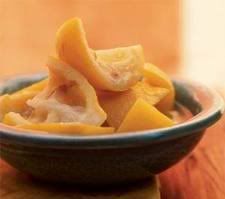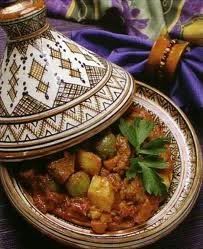At times I get obsessed. It’s TIME! For a few weeks, I have been reading, testing and tasting everything Moroccan. In New York City, we have many North African restaurants and are lucky to also have many North African street vendors that sell halal foods of all sorts. But although I love to eat out, I have been in the kitchen for weeks falling in love with things Moroccan.
 I was first introduced to North African cuisine as a student in France back in the 80s. I mostly stayed in the boundaries of the Couscous kingdom, but learned about merghuez, a spicy lamb sausage that often accompanies it. Going to the Couscouserie was so cheap and I really enjoyed the mounds of couscous soaked in spicy, tangy broth and the grilled chicken, beef and lamb. Also, North African society is so different from French society, it made a huge impression on me. It was so enriching to see two such old and beautiful cultures next to each other as a young American.
I was first introduced to North African cuisine as a student in France back in the 80s. I mostly stayed in the boundaries of the Couscous kingdom, but learned about merghuez, a spicy lamb sausage that often accompanies it. Going to the Couscouserie was so cheap and I really enjoyed the mounds of couscous soaked in spicy, tangy broth and the grilled chicken, beef and lamb. Also, North African society is so different from French society, it made a huge impression on me. It was so enriching to see two such old and beautiful cultures next to each other as a young American.
Recently, as luck would have it, I was intrigued by a demonstration I saw of how to make Preserved Lemons.  Preserved Lemons are a popular ingredient in Moroccan cuisine, and I was struck at how easy it was to do it. In modern society with refrigerators and freeze-dried technology, we forget that for most of human history, salt was how your preserved food. Preserved Lemons are basically lemons that are slowly cooked in salty water and kept in a jar for up to 6 months. As I learned about how to make the lemons, I discovered a truly awesome dish called Tajine.
Preserved Lemons are a popular ingredient in Moroccan cuisine, and I was struck at how easy it was to do it. In modern society with refrigerators and freeze-dried technology, we forget that for most of human history, salt was how your preserved food. Preserved Lemons are basically lemons that are slowly cooked in salty water and kept in a jar for up to 6 months. As I learned about how to make the lemons, I discovered a truly awesome dish called Tajine.
 Tajine refers to the earthen-clay pot that the ‘tajines’ are cooked in. Essentially stews, tajines mix meats, lamb, beef, chicken with a mix of spices that will send your taste buds into the stratosphere. Cooked slowly, a tajine recipe calls for: turmeric or saffron, cumin, paprika, preserved lemons, garlic and ginger. The meats absorb the flavors best when you allow them to marinate for 24 hours and then you simply cook the meat with water slowly for an hour or so. The really cool thing is that you can add the Preserved Lemon skins, sliced, that add an amazingly interesting taste to the stew. Also, olives or other vegetables are added as well.
Tajine refers to the earthen-clay pot that the ‘tajines’ are cooked in. Essentially stews, tajines mix meats, lamb, beef, chicken with a mix of spices that will send your taste buds into the stratosphere. Cooked slowly, a tajine recipe calls for: turmeric or saffron, cumin, paprika, preserved lemons, garlic and ginger. The meats absorb the flavors best when you allow them to marinate for 24 hours and then you simply cook the meat with water slowly for an hour or so. The really cool thing is that you can add the Preserved Lemon skins, sliced, that add an amazingly interesting taste to the stew. Also, olives or other vegetables are added as well.
 Moroccan cuisine is not bereft of bread recipes and one of the ones I find really good is called Batbout. It is essentially pita bread that you make on the top of the stove and it mixes white flour and semolina flour to form a hearty accompaniment to the tajine.
Moroccan cuisine is not bereft of bread recipes and one of the ones I find really good is called Batbout. It is essentially pita bread that you make on the top of the stove and it mixes white flour and semolina flour to form a hearty accompaniment to the tajine.
And finally, a new recipe that I have been playing with is called Zaalouk, featured on the website as the recipe of the week. Zaalouk means eggplant in Berber and is a cooked salad with eggplant, tomatoes and spices.
If you make the items that I have featured in this blog, you will begin a journey into the cuisine of Morocco and North Africa that you will never regret. Bon Appetit!

Robert Aiudi, a.k.a., The Language Chef, has been known to his friends and family as a “language junkie” nearly his entire life. He is fluent in many, conversational in others and can fake it through another large amount of some of the most exotic languages in the world. He has taught and tutored many happy students, and annoyed people over the years by asking “how do you say that?”.
From his young years surrounded by speakers of three different dialects of Italian, to university in France and German and extensive work in Asia, China, Taiwan, Japan, Robert has picked up languages and breathed in the cuisines of many countries. Translating from 27 languages into English, Robert is a repository of anecdotal and factual information about languages of all sorts which adds flavor and depth to the Language Chef.
An expert amateur cook, Robert has worked in Paris in small bistro, made pizzas in Florence, wrangled recipes out of the hands of German grandmothers in the Black Forest, worked in a Chinese restaurant and had ad hoc cooking lessons in restaurants in China, Taiwan and Japan as well as various Chinatowns. Most importantly, Robert, his mom and dad, two grandmothers and lots of aunts from Italy have made culinary magic in their kitchens for generations.








